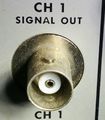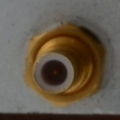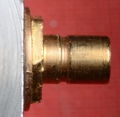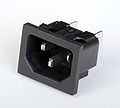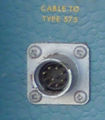Connectors: Difference between revisions
(→GR-874: links) |
(→Peltola: +drawing) |
||
| Line 81: | Line 81: | ||
<gallery> | <gallery> | ||
File:Peltola-connectors-mated.jpg | Mated connectors | |||
File:Peltola-connector-socket.jpg | Socket | |||
File:Peltola-connector-side.jpg | Side view | |||
File:Peltola-connector-tip.jpg | Tip | |||
File:peltola-connector-drawing.jpg | schematic drawing of components | |||
</gallery> | </gallery> | ||
Revision as of 22:54, 22 July 2014
Tektronix equipment makes use of a wide variety of connectors. Most of the connectors were standard parts when the instruments were designed. Occasionally custom connectors were designed. What follows is a partial list of connectors used in Tektronix equipment.
BNC
BNC is the most common connector for measurement equipment up to 1GHz. It was patented in 1951 by Hazeltine Research, Inc. It is available in different impedances. 50-ohm is the most common. Tektronix gear transitioned from UHF connectors to BNC connectors in the early to mid-1960's. For some pieces of equipment, a conversion kit was available.
-
BNC Female
-
BNC Male
SMA
SMA connectors are good to about 20GHz. The male connectors have a protruding center pin and ground shroud that screws on. They are similar to UHF connectors, but much smaller and with much tighter tolerances and better controlled impedance. The female is threaded on the outside. SMA connnectors are used on the S-52, 7T11, S-4 and S-6.
-
SMA Male
-
SMA Female
SMB
SMB connectors are small snap-on RF connectors developed in the 1960's. They come in 50-ohm and 75-ohm variants. Their RF performance in somewhat inferior to SMA connectors, but they are more compact and have the convenience of being snap-on instead of having a screw-on grounding nut. They are used in 1960's sampling and pulse gear like the 1S1, 4S1, and 284. They are also used in later equipment like the DC5010 and the 7D15. In general, SMB connectors are more widely used inside of RF equipment (on module interconnects, for example) than on front panels where SMA is more frequently found.
-
SMB Connector as Strobe Input to 4S1 Sampler
-
SMB Connector as Tripper Pulse Input to 284 Tunnel Diode
GR-874
The GR-874 is a hermaphroditic RF connector developed by General Radio in the late 1940's. They are typically 50 ohms, but other impedances including 75-ohm and 125-ohm were available using the same ground shield and housing, but different center pin geometry. The Tektronix 519 uses a 125-ohm GR-874 connector which has the same ground housing as the 50-ohm variant, but has a center pin that is thinner and shaped differently. The regular 50-ohm version is used in the 1S1, 1S2, 3S1, 3S7, 3T7, 4S1, 4S2, 5T1, 5T1A, 5T3, 7M11, N, S-1, S-2, 106, 109, 110, 113, 280, 281, 282, and 282.
-
-
-
Two 75-ohm and one 50-ohm GR-874
Peltola
Peltola connectors are used extensively inside 7000-series scopes and plug-ins. The main signal path in all 7000-series scopes is 50-ohm differential, and Peltola connectors are used for almost all inter-board signal wiring.
The Tektronix website says the following about Peltola connectors:
The Peltola connector was developed for in-house use by Tektronix (and developed by Ron Peltola). However, the pieces to make the connector are these:
The Male coaxial connector consists of the RG-174 coax center conductor as the male pin, with the braided shield pressed between two eyelets, part number 210-0775-00 (smaller one) and part number 210-0774-00 (larger one). The outer eyelet is then "dimpled" to secure the eyelet-shield-eyelet combination.
The Female (circuit board mounted) connector consists of 2 pieces. In the center is the socket pin connector, part number 136-0252-07 and the connector recepticle (with 3 circuit board mounting tabs), part number 131-1003-00.
(See also US Patent 3742425.)
-
Mated connectors
-
Socket
-
Side view
-
Tip
-
schematic drawing of components
UHF
The UHF connector is basically a banana connector with a screw-on shield. The male is often called a PL-259, and the female is often called an SO-239. Although it is called a "UHF" connector, the connector's construction does does not provide a controlled impedance that matches the impedance of the cables it is typically used with. UHF connectors are typically used up to 300 MHz, at most. The design has been used since the 1930's, and it is used on many pieces of early Tektronix gear. Tek moved away from them in the mid-1960's. Tek provided kits that allowed owners or field technicians to convert instruments from UHF connectors to BNC connectors, which are smaller, quicker to attach and remove, and have better high-frequency characteristics (controlled impedance).
The UHF connector is used in the 511, 512, 513, 514, 515, 516, 517, 524, 525, 526, 531, 533, 535, 541, 543, 545, 551, 555, 575, 127, 1121, A, B, C, D, G, H, K, L, R, S, T, Z, 2A60, 60, 63, 72, 75, 104, 105, 107, 013-045, 013-045, and 360.
-
The 013-045 has one male UHF connector and two female UHF connectors.
Banana
According to Wikipedia, the banana connector was invented in 1924 by Richard Hirschmann. The male (plug) is a 4mm shaft that has a springy shroud so it fits snugly in the female (socket), which is a 4mm hole. In American equipment, when banana plugs are used in pairs (e.g., power and ground), it is customary to place the two banana connectors 3/4" apart. Although the 3/4" spacing is a de facto standard in America, it is problematic in Europe, where a 3/4" double banana plug can easily be inserted into a wall (mains) power receptacle by accident.
N
According to Wikipedia, the N connector was invented in the 1940s by Paul Neill of Bell Labs. The N connector is good to at least 10GHz. It is seen as the input connector for Tektronix spectrum analyzers 1L20, 1L30, 1L40, and 492. It is used for the output on the 108 pulse generator.
BSM
Several Tektronix products use BSM connectors, such as the 7T11, 11B2, 3S2, S-50. S-51, and S-52. These look like minature BNC connectors. They are much less common than BNC connectors. There are two-lug variants and three-lug variants. Tektronix used the two-lug variant. They are also sometimes called MB connectors. The 067-0587-01 uses one for TRIG OUT. The 012-0127-00 converts from BSM to BNC.
-
BSM female on front lower right of 7T11
-
BSM to BNC adapters
-
BSM panel jack
0.1" Header
IEC
IEC connectors are electrical power connectors specified by IEC standards. Mostly, the term is used for connectors in the IEC 320 standard issued in 1970 (since re-numbered to IEC 60320), and most often for the ubiquitous C13 / C14 type mains power inlet connector.
-
IEC 320 (60320) C14 power inlet
Lemo S-series
LEMO is a Swiss connector company founded in 1946. Tektronix used LEMO connectors to provide power to probes. 7000-series scopes have this connector.
-
Probe power connector on rear panel of 7104.
Octal
In some Tektronix equipment such as the 160 series, an octal connector is used. The plug resembles the bottom of a tube like a 6L6. The socket is an octal tube socket. The 160 power supply has octal sockets on the back, and octal cables bring the power to the modules such as the 161, 162, 163, and 360.
XLR
The XLR connector is most often used as a connector for microphone cables. It is used in the Tektronix Type E.
Amphenol 165-15
The Amphenol 165-15, which mates with a 165-14, is a MILSPEC connector with 9 #20 contacts and a current rating of 7.5A. It is used for the cable that connects the 175 to the 575.
GPIB

GPIB aka IEEE-488 uses a 24-pin Amphenol-designed micro ribbon connector. Micro ribbon connectors have a D-shaped metal shell, but are larger than D-subminiature connectors. They are sometimes called "Centronics connectors" after the 36-pin micro ribbon connector that Centronics used for their printers.
